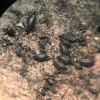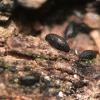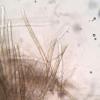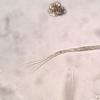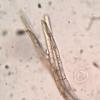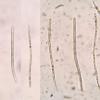
21-12-2025 09:32
Hello.A tiny ascomycete found embedded in wood in

21-12-2025 21:32
Pol DebaenstHello, Garden, Burgweg 19, Veurne, BelgiumOn 10/1

22-12-2025 23:38
Patrice TANCHAUDBonsoir, récolte sur un mur en pierre, apothéci

22-12-2025 00:47
Patrice TANCHAUDBonsoir, récolte à proximité du milieu dunaire

21-12-2025 21:40
Isabelle CharissouBonjour, j'aimerais connaitre les références de

20-12-2025 23:08
Patrice TANCHAUDBonsoir, récolte sur sol sablonneux dans l'arri�
Mytilinidion ?
Ethan Crenson,
11-03-2020 22:18
Hello all,
A friend found these last weekend in New York City. They are tiny, less then 1mm in length, mussel-shell-like fruiting bodies on well rotted conifer. They seem to turn the substrate somewhat black. The asci are cylindrical, 142-163 x 6.2-7.5µm. The spores are hyaline to very light brown/yellow, very elongated, 4-7 septate, 57-72 x 2-3µm. Based on the number of septa it seems like it should be M. scolecosporum. But the spores are somewhat too long. Based on spore length it would fit better with M. australe, but is short on septa for that species. (I am using Boehm's key)
Any ideas?
Thank you,
Ethan
Alain GARDIENNET,
11-03-2020 22:55
Re : Mytilinidion ?
Hi Ethan,
Again an amazing fungus ! Mytilinidion cf. scolecosporum indeed, but not australe, septa lacking.
Alain
Ethan Crenson,
11-03-2020 23:07
Re : Mytilinidion ?
Alain, thank you for your quick reply! Do you also find M. scolecosporum with spores that are longer than what is given in Boehm's key? On the other hand I find Oedohysterium sinense with spores that never approach the outer limit for spore length given in the key, but rather cluster in the bottom 1/3 for length. I wonder if there are simply regional variations.
On another note, I sent the other hysterioid (on Rosaceae) to you in the mail this morning.
Again, thanks! You are right, it is an amazing fungus.
Alain GARDIENNET,
11-03-2020 23:24
Re : Mytilinidion ?
I envy you finding those fungi I like so much. I don't think I found a true Mytilinidion scolecosporum. In 2007 I took my first steps in mycology and now with more experience I have doubts about this collection (maybe a Lophium mytilininum with broken spores). I have never found any scolecosporate Mytilinidion. However, I think that given the size of the spores, variations such as the ones you observe are not impossible. In this family the septation of the spores is a more reliable feature.
Alain
